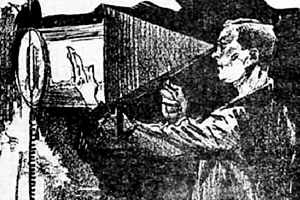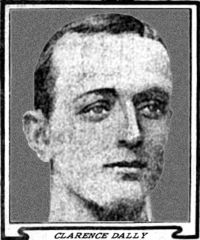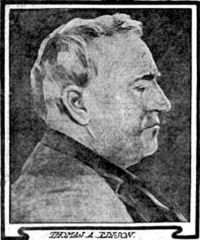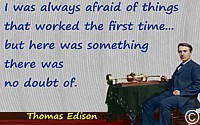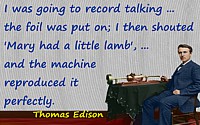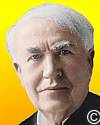 (source)
(source)
|
Thomas Edison
(11 Feb 1847 - 18 Oct 1931)
American inventor who was known internationally as “the Wizard of Menlo Park,” for the huge number of innovations coming from there, the world's first industrial research laboratory.
|
EDISON FEARS HIDDEN PERILS
OF THE X-RAYS.
WIZARD EDISON AND EMPLOYEE
INJURED BY X-RAYS AND FLUOROSCOPE,
WHICH ALMOST COST DALLY'S LIFE.
from New York World (3 Aug 1903)
That loss of sight, cancerous disease and even death may come to him who is constantly exposed to or inexperienced in the use of Roentgen rays has been demonstrated in a pitiable manner in the laboratory of Thomas A. Edison at Orange, N.J. Clarence Dally, an assistant to the “Wizard of Menlo Park,” has contributed an arm and a hand to this demonstration, while Mr. Edison himself suffers from the disturbed focus of one of his eyes through experiments with this mysterious light in an endeavor to find for it some commercial utility.
This chief sufferer, Dally, who has a wife and two boys to take care of, is left to depend entirely upon the generosity of Mr. Edison, in which interest, supplemented by an enthusiastic desire to delve deeper in that mysterious force which brings to view objects concealed in solid matter, he has been incapacitated from taking up the life burdens and duties that usually fall to a man.
The story of Clarence Dally is best told by Dr. W.B. Graves, one of the leading surgeons of New Jersey, who was seen by a World representative in his cottage on Main Street, East Orange, yesterday afternoon.
“Clarence Dally came to me nearly seven years ago,” said Dr. Graves, “and I wish to say in the beginning that I regard him a martyr to science. He is so regarded by the medical profession generally, for not one cent has ever been charged him for either surgical or medical services. He presents to science a pitiable object-lesson of the dangers of inexperienced or continuous experiments with X-rays, and his sufferings have done more to bring to professional notice a correct knowledge of things to be avoided than anything else in the history of scientific research upon this subject.
“Dally was a wiry chap, as hard as nails; a little fellow, but a specimen of perfect manhood when he left the United States Navy, in which he had been a chief gunner’s mate, to take up the practical study of X-rays, because they fascinated him. When he came to me seven years ago it was because his regular physician thought he needed the services of a surgeon. He had been following his hobby enthusiastically and had been testing tubes in the Edison laboratory, exposing himself to the forcible light with an utter disregard to himself.
“In the beginning his hair begun to fall out and his face began to wrinkle. Then dermatitis, or inflammation of the skin, set in, and manifested itself in a sore on the back of his left hand. This was caused, he told me by placing it between the fluoroscope and the X-ray tube, in order that the latter might be thoroughly tested, or perhaps by the light falling upon his hand as it passed the flange of the instrument as he held it. There was no sensation of acute pain, only a soreness and a numbness. In other words, he had used his own person continuously to test the tubes.
“He was doctored carefully with a view to curing the skin disease upon the back of his hand, but it grew worse instead of better, all the methods of treatment failing to influence it. Then arterio sclerosis, or a thickening or hardening of the arteries set in, and this extended even to the most minute blood vessel in his arm.
“There was no paralysis, but the drying up of the blood vessels took away the nourishment from the tissue and prevented the sore on his left hand from healing. The right hand was also affected, even to the finger tips, but it was not in such a serious condition as the left.
“The trouble in his left hand finally developed into a skin cancer, and the whole arm, away up above the elbow, and well into the biceps, was affected. There was a consultation of physicians, and it was agreed that he must be operated upon at once or the poisonous cancer would place his life in jeopardy. This was after five years treatment, with the very best medical advice obtainable, in an endeavor to save his left arm.
“Two years ago this arm was amputated. The operation was performed by Dr. Lloyd, of the Post Graduate Medical School, which operation I attended. The amputation was about three inches below the shoulder, all above that being healthy.
“I then turned my attention to the right arm, with a view to saving it, but it began to manifest the same disposition as the amputated arm, and a short time ago I took off four of Dally’s fingers, so that now he has but one thumb on one hand with which to earn his livelihood. It is impossible for him to work, and he must live on the bounty of Mr. Edison or starve.
“I do not think there is further danger to be apprehended, unless he pursues his X-ray experiments in some other direction. He is an enthusiast upon the subject.
“Dally’s case has told science that the continuous exposure of any part of the human anatomy to the influence of the X rays is deadly to the part so exposed. Of course, it does not interfere with the use of the light for medical purposes when it is handled by experienced persons, but it is not a thing to be trifled with. Under proper care it is of great use.
“I dressed Dally’s hand yesterday, just before he started away on his two weeks’ vacation, and it is healing nicely.”
Dr. F.B. Lane, of No. 31 Halstead street, East Orange, who was Dally’s physician prior to the turning over of his case to the surgeons, contributed some interesting information regarding the cause of the student’s affliction.
“I turned Dally over to Dr. Graves,” said he, “because I thought he needed a surgeon. There was a cancerous formation on his left hand that I thought needed a knife. How was it caused? It was burned. Dally was, among other things, a glass-blower, and he made the bulbs for the X-ray tubes used in the Edison laboratory. He tested them too, and he tested them by placing his hand between the fluoroscope and the light. He did this continuously, day after day, until he simply burned up the blood vessels in his hand.
“He would have been dead now if I had not sent him to Dr. Graves and if the operation had not been performed. He has been one of the greatest sufferers I ever saw.
“Dally made a hobby of X-rays. When Edison set up his machines in the Crystal Palace, Dally did the mechanical work. And then he put his head up in front of the light in order that people might look through it. The result was that his hair and mustache fell out.”
Another sufferer from the use of X-rays, Mr. Edison, himself, was seen at his home in Llewellyn Park, Orange, by a World reporter and asked to tell the story of the experiment which disabled Dally and came near making Mr. Edison sightless.
“Don’t talk to me about X-rays,” he said. “I am afraid of them. I stopped experimenting with them two years ago, when I came near to losing my eyesight and Dally, my assistant practically lost the use of both of his arms. I am afraid of radium and polonium too, and I don’t want to monkey with them.
“Up to two years ago, I was deeply interested in X-rays. I used the fluoroscope which I invented—a pyramidal scope with one open end, the smaller and larger closed end, the covering being a chemical sheet against which the object to be examined is placed, the rays being focused upon it. I was making experiments in a dark room that I had constructed in one end of the laboratory. I was looking for an improved crystal, and there was daily results that fascinated me and kept my eye glued to the fluoroscope virtually all the time.
“I used my left eye, and one day when I came out of the dark room and closed my right eye for a moment everything looked double. I hastened to an oculist, who said that my eye was something over a foot out of focus. It is still imperfect, and I do not think that it will ever be entirely well.
“When I noticed the effect upon my eye I cautioned Dally. I told him that there was a danger in the continuous use of the tubes, but he persisted because he was so enthusiastic upon the subject. The only thing that saved my eyesight was that I used a very weak tube, while Dally insisted in using the most powerful one he could find.
“The box of the fluoroscope only partially covered his face, so that the light fell upon his hair and made it fall out—that is: what was left of it after exposing his head to the light in a reckless way to illustrate its power. Part of his hand and arm were exposed to the action of the light.
“I am keeping him on the payroll, although he is not able to do any work, and I expect to take care of him as long as he lives. I have sent him away on a vacation to Woodbridge, N.J., where the change may do him good.”
“Speaking of radium, Mr. Edison, what is your opinion of it?” asked the World reporter.
“I have had several pieces of it from Mme. Curie in Paris, and I have experimented with it. I do not see its commercial utility, but it opens up a great field of thought and scientific research. It overturns all the old theories of force and energy and has set scientists to thinking. Do I believe that it is the solution of perpetual motion? No, I have a peculiar theory about radium, and I believe it is the correct one.
“I believe that there is some mysterious ray pervading the universe that is fluorescing to it. In other words, that all its energy is not self-constructed but that there is a mysterious something in the atmosphere that scientists have not found that is drawing out those infinitesimal atoms and distributing them forcefully and indestructibly.”
“Did you ever find any commercial utility in the X-rays, or radium?”
“My researches, I might as well tell you now that I have abandoned them, were in the direction of making a fluorescent lamp. I obtained results which brought me each day nearer to the object of my desire. I found a crystal that was fluorescing 12,000 times, and I thought I had my lamp. Then came the question of practical use. I could make the lamp all right, but when I did so I found that it would kill everybody who would use it continuously.
“No, I did not want to know anything more about X-rays. In the hands of experienced operators they are a valuable adjunct to surgery, locating as then do objects concealed from view, and making, for instance, the operation for appendicitis almost sure. But they are dangerous, deadly, in the hands of inexperienced, or even in the hands of a man who is using them continuously for experiment. There are two pretty good object-lessons of this fact to be found in the Oranges.”
- Science Quotes by Thomas Edison.
- 11 Feb - short biography, births, deaths and events on date of Edison's birth.
- First Thomas Edison Lamp Factory - from Edisonia (1904)
- Thomas Edison Quote “Mary Had A Little Lamb” - Illustrated quote with Tinfoil Phonograph - Medium 500 x 350px
- Thomas Edison Quote “Mary Had A Little Lamb” - Illustrated quote with Tinfoil Phonograph - Large 800 x 600px
- The Talking Phonograph - Thomas Edison's invention of his tinfoil phonograph - article in Scientific American (22 Dec 1877) - with illustrated quote, medium 500px.
- Thomas Edison Quote “Something there was no doubt of” - Illustrated quote + tinfoil phonograph engraving 800px
- Thomas Edison - context of quote “Genius is not inspired. Inspiration is perspiration.” - Medium image (500 x 350 px)
- Thomas Edison - context of quote “Genius is not inspired. Inspiration is perspiration.” - Large image (800 x 600 px)
- Thomas Edison Quote “Something there was no doubt of” - Illustrated quote + tinfoil phonograph engraving 500px
- 1 Oct - short biography, births, deaths and events on date of opening of Edison's Menlo Park lamp factory.
- Edison: A Biography, by Matthew Josephson. - book suggestion.
- Booklist for Thomas Edison.
